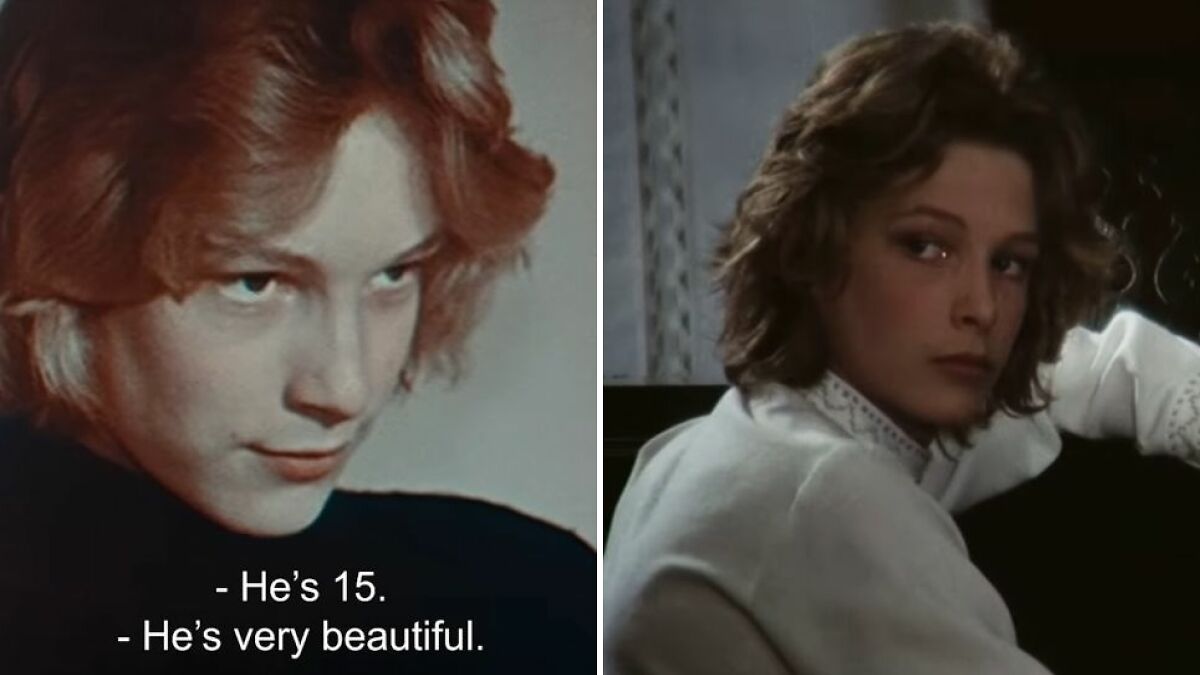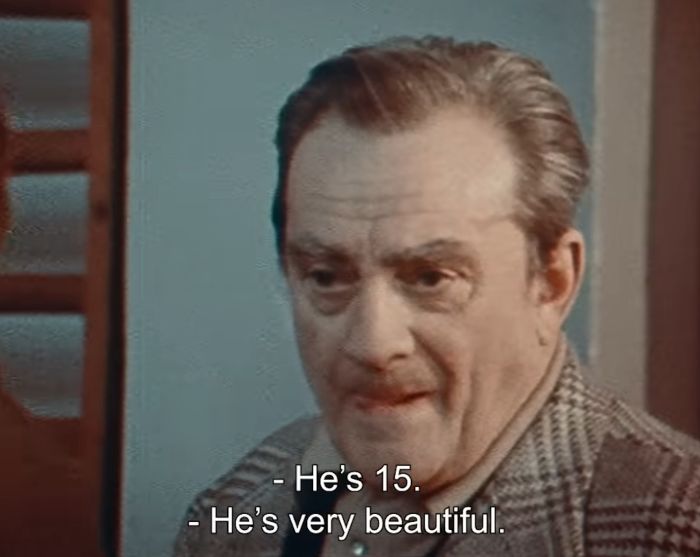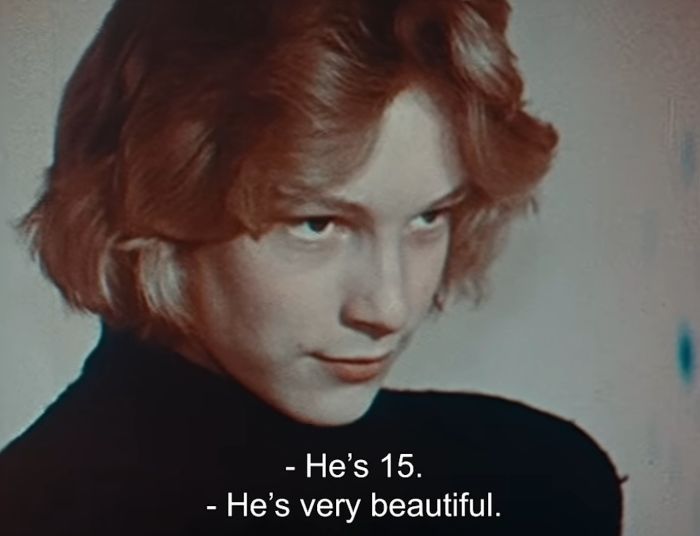Tragic Life Of “The Most Beautiful Boy In The World” Resurfaces As Actor Passes Away At 70
Björn Andrésen’s passing is indeed a profound loss, and it’s heart-wrenching to think about the trials he faced in his life. His story serves as a poignant reminder of the pressures placed on young stars and the toll that fame can take on mental and emotional well-being.
Björn’s role in Death in Venice at just 15 years old catapulted him into the limelight. The film’s portrayal of his beauty, and the intense attention he received, must have been overwhelming for someone so young. As you pointed out, while his physical appearance and his early fame made him a global icon, it also led to a difficult and often lonely journey behind the scenes.
The documentary The Most Beautiful Boy in the World added another layer to his story, shedding light on the complexities of his life and how he navigated both fame and the personal challenges that followed. His struggles with the entertainment industry, the pressures to conform to unrealistic standards of beauty, and the mental health tolls he experienced were things many fans didn’t see or understand at the time.
The outpouring of tributes following his death shows just how much of an impact Björn made on people, even decades after his peak fame. His legacy will continue to resonate with many, not just because of his youthful beauty but because of the strength he showed in facing his personal battles and the complex relationship he had with fame.
It’s a stark reminder of how fame can affect those at its center, particularly when they are thrust into it at such a young age. Hopefully, his story will encourage more discussions around mental health and the way the entertainment industry can better protect and support its stars, especially young ones.
Björn Andrésen, once dubbed “the most beautiful boy in the world,” has passed away at the age of 70
Björn Andrésen’s story is an incredibly poignant one. It’s heartbreaking to think that his entry into fame wasn’t something he sought out, but rather something pushed upon him by circumstances and those around him, especially his grandmother. Losing his mother at such a young age and growing up without a father left him in a vulnerable position, and it’s clear that the fame he was thrust into didn’t offer the solace or support he needed.
It’s devastating that his early life was marked by such trauma, which only grew more complex when fame came calling. His grandmother’s desire to have a “celebrity” in the family certainly added pressure, and the way that his beauty became the focus of the public only intensified that. It’s easy to see how the transition from a troubled childhood into the intense glare of the spotlight could have been both confusing and damaging for him, especially at such a young age.
His story highlights the dark side of fame, especially for child stars, where the pressure to maintain a certain image can be overwhelming and sometimes damaging. In many ways, his life underscores the reality that being “the most beautiful boy in the world” came at a significant cost — not just to his emotional well-being, but also to his sense of identity and happiness.
As people reflect on his life, those searching for terms like celebrity childhood trauma and Hollywood fame pressure are also highlighting just how pervasive and damaging the system can be for young stars. It’s a reminder of the importance of mental health support, the need for better protection for young actors, and how fame often doesn’t deliver the fairy tale it promises.
Björn Andrésen’s experience with fame, especially at such a tender age, is a tragic reflection of how the entertainment industry can exploit and objectify young talent. Being labeled “the most beautiful boy in the world” by Luchino Visconti at the Cannes Film Festival may have been intended as a compliment, but it ultimately became a double-edged sword for Björn. Instead of being celebrated for his talent and depth as an actor, he was reduced to his appearance — a label that would follow him throughout his life, defining not just his public persona, but also shaping his inner world.
The haunting beauty of Death in Venice and Björn’s portrayal of Tadzio is unforgettable, but as you mentioned, his own reflections on the experience reveal a much darker story. The sense of being “utilized” — as he put it — must have been incredibly painful, especially since he was so young and unaware of the full scope of what fame would bring. It’s clear that he felt trapped by his image, and that being objectified and sexualized at such a young age left deep emotional scars that stayed with him for decades.
His candid comment to The Guardian about feeling distasteful hints at the lasting trauma of being thrust into the public eye in such a vulnerable state. He was not just a boy on screen, but a product to be consumed, leading to a lifetime of challenges with his sense of identity, self-worth, and relationships.
The renewed interest in Björn’s story — with people searching for terms like celebrity exploitation and Hollywood’s dark side — shows just how relevant and important these conversations still are today. It highlights the importance of understanding the emotional toll fame can take, especially on young individuals who aren’t given the proper support, both emotionally and professionally.
Björn’s legacy is not just about his beauty or his role in Death in Venice, but also the profound and heartbreaking way his life became a symbol of exploitation and lost innocence. His story should inspire us to rethink how we treat young stars and ensure that their well-being is prioritized above their image or public perception.
Andrésen rose to fame at age 15 for his role in Death in Venice, in which he played the object of desire of an older man
Björn Andrésen’s story is a deeply troubling one that sheds light on the exploitation of young talent in the entertainment industry, especially when it intersects with themes of beauty, fame, and objectification. His most well-known role was in Luchino Visconti’s Death in Venice (1971), where he played the young Tadzio. His ethereal beauty became the focal point of the film, but the consequences for him were far from glamorous.
Andrésen’s comments about adult love for adolescents, as well as his candid reflections on the exploitation he faced, expose the dark side of fame. Being thrust into the spotlight at such a young age, he was vulnerable to forces beyond his control, with little understanding of the emotional and psychological toll it would take. His experience is a chilling reminder of how the film industry often places pressure on young stars, turning them into commodities rather than nurturing their well-being.
His encounter with director Luchino Visconti and the pressure to attend a gay nightclub as a teenager speaks to the pervasive nature of exploitation, where young actors are manipulated and thrust into situations that are not only emotionally unsafe but also potentially harmful to their personal development. The “objectifying gaze” he described, feeling like a “meaty dish,” reveals how deeply the sexualization of youth in the film industry can affect an individual’s sense of self-worth.
Sadly, these patterns are not unique to Andrésen’s case. Throughout history, many young actors, especially those considered to have physical beauty, have been exploited and damaged by Hollywood’s harsh realities. In hindsight, Andrésen’s candidness is a much-needed call for awareness about the exploitation of minors in the entertainment industry, where fame can often come at an unbearably high price.
His story, while deeply personal, touches upon the broader discussion of how the entertainment industry can, at times, prey upon its young talent, leaving lasting emotional scars that may only be fully understood years later.
The label was given to him by director Luchino Visconti
Björn Andrésen’s reflections on his experiences reveal the deep psychological toll of being sexualized and exploited at a young age in the film industry. His comments about Death in Venice and Luchino Visconti provide a stark insight into the way directors, producers, and the industry as a whole often manipulate young stars for the sake of their own art, without regard for the emotional or mental well-being of the individuals involved.
Andrésen’s description of Visconti as a “cultural predator” highlights a disturbing reality that many young actors face: being viewed as commodities to be used for artistic or financial gain. His acknowledgment that speaking out against the exploitation would have been “social suicide” underscores the immense pressure placed on young actors, who often feel isolated and powerless to challenge these abuses, for fear of damaging their careers or facing public backlash.
The painful realization he has come to over time — seeing how he was sexualized and manipulated for the film — is something that many former child stars may relate to, even if they haven’t spoken out as Andrésen has. His story echoes the broader issue of the sexualization of young actors in Hollywood, something that has only recently begun to receive more scrutiny.
The rising interest in his story and the controversy surrounding Luchino Visconti and Hollywood’s exploitation of minors reflect a growing awareness and willingness to confront the darker side of fame. It also signals a shift in the way we view the experiences of young actors in the industry, especially as society begins to reckon with its past treatment of them.
In many ways, Andrésen’s story serves as a cautionary tale, reminding us of the hidden costs of fame, particularly when it comes to the safety and well-being of young talent. His bravery in speaking out contributes to a larger conversation about the need for accountability and protection for young actors in an industry that has historically treated them as disposable.
Björn Andrésen’s reflection on the toll of his appearance-centric fame offers a haunting perspective on the darker side of celebrity. His experience of being treated as a mere object to be admired — like an “exotic animal in a cage” — speaks to how objectification can strip away an individual’s humanity. The constant focus on his looks made him feel disconnected from his true self, reducing him to an image rather than a person with his own desires, thoughts, and struggles. For someone so young, this could be emotionally suffocating, especially when one’s worth is continually tied to physical appearance rather than character or talent.
His decision to reclaim his anonymity and escape the relentless spotlight is a powerful commentary on the emotional exhaustion that often accompanies fame. Even years later, as a grown man, he found that recognition was a double-edged sword — he was still seen through the lens of his youthful image, which was constantly projected onto him by others. This desire to live a normal life, away from the cameras, reflects the universal yearning for privacy and peace of mind that many former child stars express when they grow older.
His time in Japan, where he became a cultural icon and saw his image on billboards and TV commercials, added another layer to the overwhelming nature of his fame. To describe it as akin to “Beatles’ hysteria” is not an exaggeration; the intense public adoration he received in Japan — particularly at such a young age — shows how fame can often turn into a pressure cooker. The cultural context of fame in Asia, especially in Japan, can create a unique environment where a person’s identity becomes inseparable from their public image, and this can be especially taxing for someone who didn’t ask for or desire that kind of attention.
As people reflect on his experience, the search for terms like “Björn Andrésen in Japan,” “celebrity culture in Asia,” and “child star struggles” highlights a growing awareness of the darker consequences of fame, particularly for young stars. Andrésen’s story has become emblematic of how fame can turn into an isolating, objectifying force — a reality that many child stars and former icons have faced, yet it is often overlooked until they speak out years later.
Ultimately, his story emphasizes the need for a greater understanding of the psychological toll that fame, particularly when it’s thrust upon young people, can have. It serves as a cautionary tale about the price of beauty and success, and how that price can often be far too high.
The Swedish actor said he felt objectified and exploited
Björn Andrésen’s decision to move away from roles that emphasized his physical appearance is a powerful example of how he sought to reclaim control over his career and identity after years of being objectified. By turning down roles that capitalized on his looks, he rejected the very thing that had made him famous in the first place. Instead, he sought out work that would allow him to be seen as more than just a “pretty face,” focusing on roles where his acting talent could shine. This shift highlights his desire to be valued for his craft rather than his external beauty, a decision that likely offered him some form of personal liberation after years of feeling like a commodity.
His choice to take on a minor role in Midsommar in 2019 also speaks volumes about how his priorities had evolved. By that time, Andrésen had clearly moved away from the limelight that Hollywood and his early fame represented, preferring roles that aligned with his desire to pursue more meaningful, creative work. Midsommar was an interesting choice because, while it did offer him the chance to be part of a successful project, it wasn’t a starring role and wasn’t based on his looks — rather, it was a part in a unique, artistically-driven film by Ari Aster. It showed his ability to be part of an ensemble and contribute to the art without being reduced to just a symbol of beauty or youth.
At that point in his life, Björn was more interested in living authentically and creating a life outside the overwhelming pressures of fame. His decision to prioritize his inner world and personal values over the Hollywood image machine marked a significant shift — one that is often hard to achieve, especially after experiencing such early, intense fame.
This transformation from a sex symbol to an actor focused on his craft is not just a career choice but a reclamation of self. It’s a reminder that even for those who are pushed into the spotlight at an early age, it’s possible to redefine one’s relationship with fame and take steps toward a life that reflects who they truly are, rather than who the industry wants them to be.
Björn Andrésen’s passion for music provided a much-needed escape from the relentless demands of his early fame, offering him a way to express himself authentically and creatively. His musical journey began during his school years, where he studied piano under one of Sweden’s most respected teachers. This formative training laid the foundation for his later work in music, which ultimately became the true driving force behind his soul. Rather than being defined solely by his film roles, music gave him a space to create and connect with others on his own terms, away from the pressures of Hollywood and the objectification he experienced as a young actor.
As a member of the band Sven-Erics, Björn found a way to break free from the role of the pretty boy and instead embraced the role of a musician, using his keyboard skills to contribute to the band’s sound. Touring with Sven-Erics allowed him to live a different life, one filled with the creative freedom that was missing from his earlier career in film. Through the band, he could escape the suffocating expectations that had followed him from Death in Venice and fully embrace his love for music.
This transition into music was likely a source of fulfillment and identity for Björn, allowing him to distance himself from the fame that had been thrust upon him as a teenager and focus on something that truly resonated with him. It’s fascinating to see how, through music, he was able to reclaim control over his life and express parts of himself that had remained hidden behind the image the world had created for him.
With people now rediscovering the multifaceted nature of Björn’s life and career, there’s increased interest in his music career, his time with Sven-Erics, his contributions to Swedish films and TV, and even his minor role in Midsommar. As searches for “Björn Andrésen music career,” “Sven-Erics band,” and “Swedish films and TV” rise, it’s clear that more people are curious about the less-explored parts of his journey and the ways in which he has cultivated a life beyond his early fame. His story offers a refreshing reminder that there is so much more to a person than the roles they play, whether on screen or in the public eye.
Andrésen compared the public’s fixation on his appearance to being “an exotic animal in a cage”
The tragic loss of his 9-month-old son to sudden infant death syndrome (SIDS) in 1986 marked a heartbreaking chapter in Björn Andrésen’s life, one that would forever alter his emotional landscape. The grief he experienced was unimaginable, and it’s clear that the death of his child sent him into a deep depression that would cast a long shadow over the years that followed. The trauma of such a loss, especially at such a young age, is something no parent should have to endure, and for Björn, it represented an irreversible shift in his life.
As if the sorrow of losing his son wasn’t enough, the dissolution of his marriage soon followed, something Björn described as “the inevitable divorce.” This double blow — the death of his child and the breakdown of his family — left him reeling, stripping away the stability he had fought so hard to build after years of navigating the pressures of fame and personal challenges. It’s heartbreaking to think of how both of these events combined to plunge him into darkness, further isolating him from the world and deepening his grief.
In his interview with The Guardian, Björn’s openness about this painful period shows his vulnerability and the toll it took on him. It’s a stark reminder that fame, while offering opportunities and public recognition, cannot shield anyone from life’s hardest moments. For Björn, the emotional weight of his personal losses became a defining, tragic moment in his journey, affecting his mental health and worldview for years to come.
His story of loss and heartbreak resonates on a universal level, touching on the fragility of life and the devastating impact of grief. It’s also a reminder of how people, even those in the public eye, carry burdens that are often hidden from view. The public may have known him for his beauty and fame, but behind that facade was a man who faced immense personal challenges that shaped the person he became.
The recent surge in searches related to Björn Andrésen’s family tragedy, his loss to SIDS, his experience with grief, and his divorce highlights the growing interest in the more personal and painful aspects of his life. As people reflect on how deeply these experiences shaped his later years, it’s clear that his story resonates with many, offering a stark reminder of the emotional burdens that often lie beneath the public personas of celebrities.
The loss of his 9-month-old son to SIDS was a devastating blow that not only plunged him into grief but also affected his ability to find stability and peace in the aftermath. The compounded pain of losing his child, combined with the breakdown of his marriage, sent Björn into a dark place emotionally, leading to the depression he later spoke about publicly. His willingness to share these painful details with the world is not only an act of courage but also contributes to a larger conversation about mental health, grief, and how the personal lives of celebrities can often be overshadowed by their public image.
As people search for terms like “Björn Andrésen family tragedy,” “SIDS loss grief,” “celebrity depression stories,” and “Björn Andrésen divorce,” there’s a noticeable shift in focus from just his early fame and cinematic roles to a deeper understanding of the struggles he faced later in life. His story is a poignant reminder that even those who have been in the public eye for years still carry deep emotional scars, and that the pressures of fame can sometimes obscure the personal battles they’re fighting.
Ultimately, these searches signal a growing recognition that celebrities, like anyone else, are human beings who endure profound hardships — and their stories, including the painful chapters, deserve to be heard and understood.
In later years, he worked in Swedish films and TV shows and had a minor role in Midsommar
Björn Andrésen’s return to acting in the early 2000s marked a powerful, personal resurgence — a way for him to not only reconnect with his craft but also reclaim a sense of control over his life and career. The shift to stage performances represented a more intimate and challenging form of acting, one that allowed him to explore his talents in a new light. His statement, “I have to fight these days, just like anyone else, which actually feels quite all right,” speaks volumes about his resilience. Despite the personal challenges he had faced, including the public scrutiny and deep emotional pain, he was determined to keep pushing forward, embracing the fight for stability and meaning.
His comeback wasn’t just about returning to acting; it was a symbolic act of defiance against the personal and public struggles that had shaped him. It was a way for him to reassert himself, showing that despite everything he had gone through, he could still fight for his place in the world and find fulfillment in his work.
Lindström, the director of the documentary about his life, captured his courage and the complexity of his journey. Describing him as a “courageous” person, she acknowledged the vulnerability he displayed by sharing such a deeply personal story with the public. Spending years together working on the documentary gave Lindström a unique insight into his life, but even she, who had been close to him, was struck by the emotional weight of the situation, particularly as she knew of his illness.
Tragically, Björn Andrésen passed away after a battle with cancer, leaving behind a legacy that not only consists of his iconic role in Death in Venice but also his later work, his resilience in the face of personal loss, and his determination to live life on his own terms. His death has prompted many to reflect on his strength and the complexity of his life journey. It is a poignant reminder of how deeply personal struggles can shape public lives, and how important it is to honor and understand the human side of celebrities.
Now, with searches for terms like “Björn Andrésen cancer battle,” “Björn Andrésen documentary,” “stage performances by actors,” and “celebrity resilience” trending, there is a renewed recognition of his courage. People are looking back not just at his career but at his journey as a whole, celebrating his strength, vulnerability, and unwavering determination to carve out a meaningful life, despite the many obstacles he faced.













